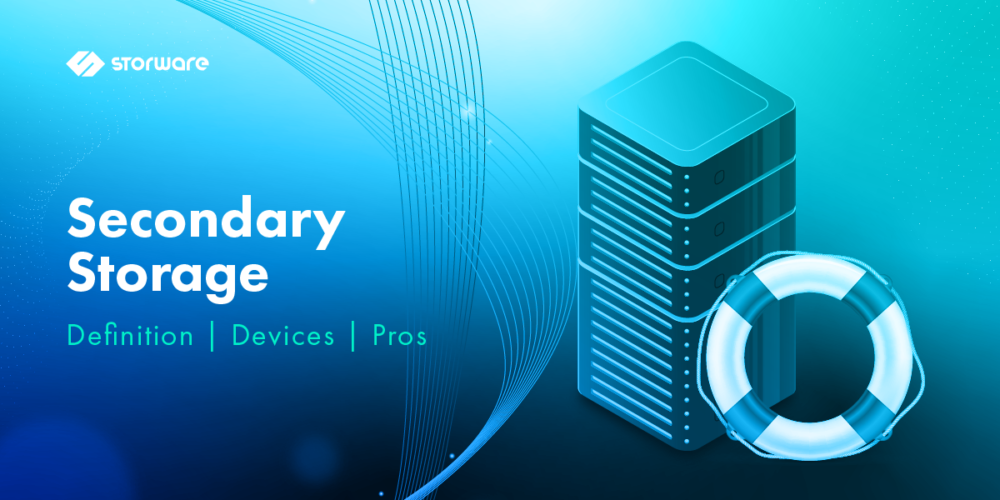辅助存储:定义、设备及其如何支持备份策略
Data is a valuable resource for both individuals and companies. However, the key is to remember that data can be lost, corrupted, and in some cases become unretrievable. This requires a backup strategy; having a backup solution ensures that your data is safe and can be recovered quickly if the unexpected happens.
Primary storage devices, such as internal hard drives and flash drives, can be used to store data. However, they may need to be more reliable or have sufficient backup capacity. This is where secondary storage comes in; it’s an excellent backup solution that can successfully complement your data backup strategy. However, in order to maximize the utility of this tool for your company, you must first understand how it works.
Therefore, this blog will cover secondary storage, including appliances and how they can help your backup strategy.

What is secondary storage?
Secondary storage is not directly connected to the computer’s central processing unit (CPU). It is often used for data backup and is usually removable for easy movement and storage. Unlike primary storage devices such as internal hard drives, secondary storage devices can provide larger storage space for data backup and are generally more reliable.
Importance of secondary storage in backup strategy
Having a secondary storage solution is crucial to protecting your data from loss or damage. Imagine losing important files, family photos, or business records due to a hard drive failure, a malware attack, or even a natural disaster like a flood or fire. With secondary storage, you can be confident that your data is safe and can be recovered quickly if the unexpected happens.
Secondary storage device
There are three main formats for secondary storage. They include external hard drives, solid-state devices, and network add-ons.
external hard drive
An external hard drive is a removable, removable storage device that connects to a computer via USB, Thunderbolt, or other interfaces. They are popular backup solutions because they offer high storage capacities from 1TB to 8TB or more at affordable prices. They also have higher data transfer rates than other secondary storage devices, making them an attractive option for users who need to transfer large amounts of data quickly.
Solid State Drives (SSDs)
Solid-state drives (SSDs) are non-volatile storage devices that use NAND-based flash memory to store data. They are increasingly popular in backup applications due to their faster read and write speeds and greater durability than traditional hard drives. However, they are more expensive than external hard drives with the same storage capabilities.
Network Attached Storage (NAS)
Network-attached storage (NAS) devices connect to a network to store and share data between multiple computers or devices. They are generally more expensive than external hard drives and require technical knowledge to set up and manage. However, they offer important benefits for businesses with multiple employees who require remote access and data sharing.
How secondary storage supports your backup strategy
You can use secondary storage for backups in a variety of ways, including full backups and incremental backups.
A full backup is an exact copy of all the data you wish to back up. In contrast, incremental backups only copy changes that have occurred since the last backup. Incremental backups are faster and utilize less storage space than full backups, but require recovery in the event of data loss.
In addition, backup software can also make data backup more convenient and efficient. Most external hard drives and SSDs come with backup software that allows you to schedule automatic backups, back up specific files or folders, and even encrypt backups for added security.
Cloud backup solutions are becoming increasingly popular for providing a convenient and secure way to back up your data remotely. In cloud backup, your data is stored in a remote data center. Data can be accessed and recovered from any device with an internet connection. Therefore, cloud backup is a good choice for people who travel frequently or work remotely.
Factors to consider when choosing secondary storage
Choosing the right secondary storage is critical to ensuring effective and efficient data backup. When selecting a secondary storage device, several factors must be considered, including storage capacity, speed, reliability, and interfaces.
storage
When choosing a backup storage device, its storage capacity is one of the key factors. The storage capacity of a device determines how much data it can hold. Therefore, it is crucial to choose a device with enough storage capacity to meet your needs, especially if you have a large amount of data to back up.
speed
The speed of your device determines how quickly your data can be backed up and restored. Faster devices save backup time and facilitate data retrieval. Several factors that affect the speed of a device include the type of interface used, the storage medium (such as a hard drive or solid-state drive), and the amount of data transferred.
reliability
Another key factor when choosing secondary storage is reliability. Devices should be reliable and have low failure rates to reduce the risk of data loss. Factors that affect equipment reliability include component quality, manufacturing processes, and the manufacturer’s warranty.
interface
Another key consideration when choosing a secondary storage device is the interface that connects it to your computer or network. There are various interfaces including USB, Thunderbolt, Ethernet and Firewire. The interface affects data transfer speed, ease of use, and compatibility with the computer or network.
Best practices for using secondary storage as a backup solution
Secondary storage devices provide an efficient and reliable way to back up critical data. However, using secondary storage as a backup solution requires implementing best practices to ensure data integrity, reliability, and security. Organization, file management, and backup testing are best practices for setting up secondary storage devices.
data organization
Organizing data in a structured and consistent manner is critical to maximizing the benefits of secondary storage. It helps find data quickly, reduces the risk of data loss, and reduces the likelihood of backup errors. Additionally, creating file hierarchies that make sense to users or the business, setting consistent naming conventions, and finding and eliminating duplicate files are all examples of proper data organization.
file hierarchy
File hierarchy is a way of organizing files and folders in a logical and efficient manner. Establishing a file hierarchy for backup data ensures that files are easy to find and backups are complete. For example, if your company has multiple departments, such as finance, human resources, and marketing, you can create different folders to hold their information.
Consistent naming convention
Consistent naming conventions make files and folders easy to identify and ensure they are backed up accurately. A well-structured naming convention might include the date the file was created, the file type, and a brief description of the file’s contents. This approach saves time and minimizes the possibility of errors during the backup process.
Identify and remove duplicate files
Duplicate files can take up significant storage space, increasing backup time and costs. Therefore, identifying and eliminating duplicate files is critical to keeping backups efficient and cost-effective. There are various free and commercial software applications available for finding and removing duplicate files from secondary storage devices.
File management
Proper file management methods are crucial to maintaining reliable backups and reducing the risk of data loss. The following are recommended practices for file management to help ensure backups are reliable and efficient.
Implement version control
Version control tracks file changes and ensures that previous versions of files are supported when access is needed. This approach involves generating multiple versions of a file over time and assigning each version a version number or date.
Maintain a regular backup plan
Regular backup plans ensure consistent data backup and reduce the risk of data loss. The frequency of backups depends on the value of the data and how often it is updated. For example, companies that deal with frequently updated data might consider hourly or daily backups. In contrast, individuals who primarily have the same data might consider weekly or monthly backups.
Encrypt sensitive data
Encrypting sensitive data before backing it up is critical to protecting the security and confidentiality of your data. Encryption prevents unauthorized access to data, making it nearly impossible for hackers or other hostile actors to steal important information.
Backup test
Testing backups after moving data to secondary storage is critical to confirm its reliability and ensure that all data is properly backed up. After creating a backup, test to confirm it is accurate and accessible if needed. By doing this, you can detect any potential issues in your backup, such as missing or corrupted data.
Additionally, regularly testing backups is critical to maintaining their reliability and timeliness, as this helps incorporate changes to your data and backup procedures. This can also help detect any issues with the backup process before data loss occurs.
final thoughts
Secondary storage devices are a key component of any backup strategy. They provide a reliable and secure way to store your data offline, protecting it from loss or damage.
External hard drives, solid-state drives (SSDs), and network-attached storage (NAS) are all popular secondary storage options, each with their own advantages and disadvantages. When choosing a secondary storage device, consider storage space, speed, reliability, portability, and affordability.
With the right backup system in place, you can be confident that your data is safe and can be recovered quickly if a disaster strikes.
